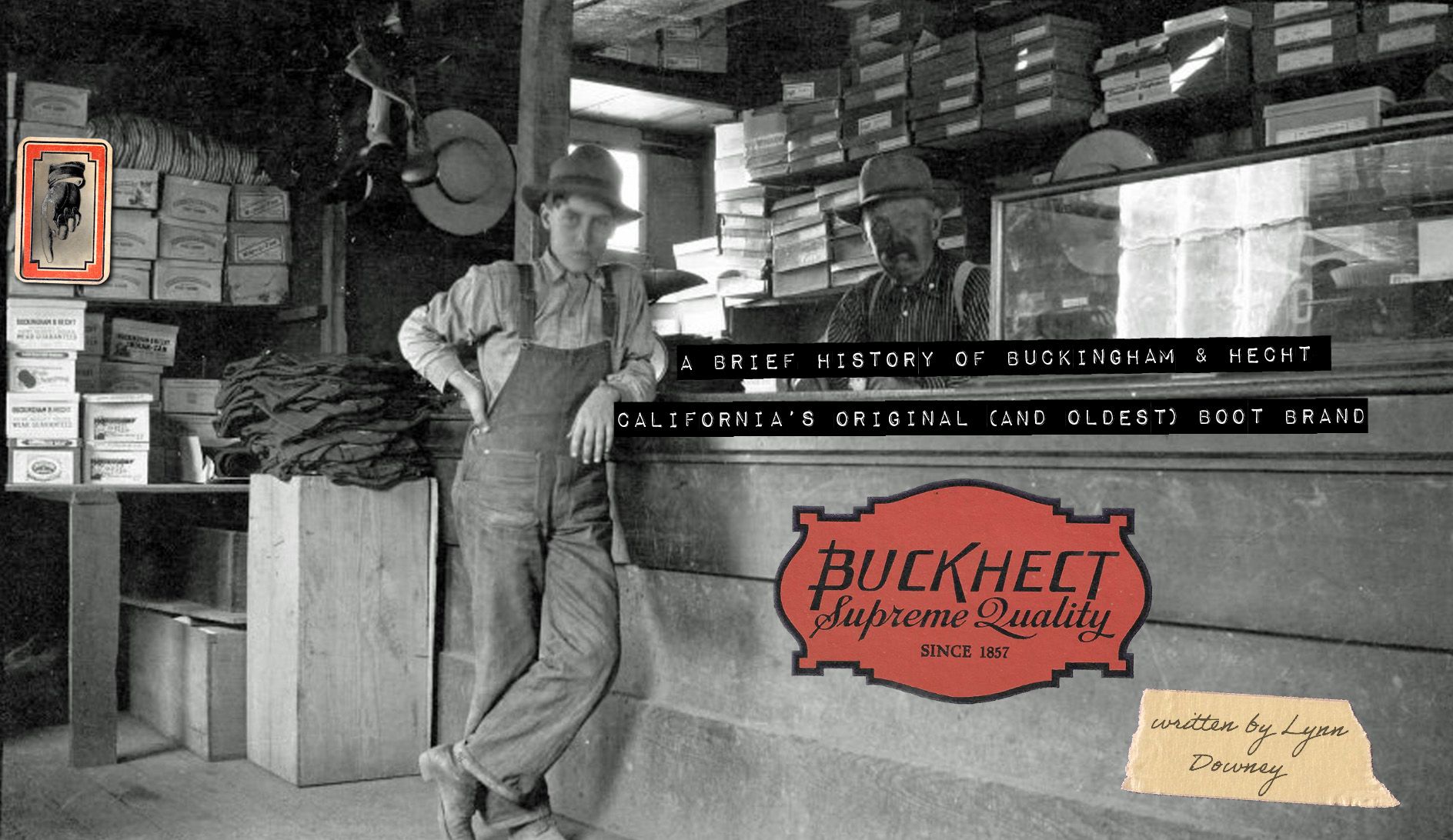
Gold Rush Beginnings
The founders of Buckingham & Hecht picked the perfect place and time to start something new: 1850s San Francisco. By the time the Hecht brothers and their future partner Thomas Buckingham set foot in town, San Francisco had moved beyond its wild Gold Rush youth and was poised to be the economic powerhouse of the Pacific. The waterfront was crowded with shops, restaurants, and offices, and businesses of all kinds were in place to serve the waves of new arrivals who stepped off steamships nearly every day. It’s not a surprise that the founding companies of San Francisco supplied whatever a new resident could require: Wells Fargo (banking) Ghirardelli (chocolate), Levi Strauss & Co. (dry goods and later jeans), and Boudin (sourdough bread). What else did they need? Boots and shoes. A new firm would soon be in place to give the men of San Francisco and the West just what their feet needed.

1870s era Buckingham & Hecht boots. Identifiable only by the logo embroidered on the pull straps
1870s era Buckingham & Hecht boots. Identifiable only by the logo embroidered on the pull straps



Emigrants and New Citizens
Elias Hecht and Helena Bamberger met and married in Hainstadt, in the German region of Baden, and Isaac was born in 1832, the first of their seven children. He was soon followed by Jacob, Fannie, Abraham, Louis, Marcus, and Henrietta. Revolution and turmoil rocked Germany in 1848, and the Hecht family made the painful decision to leave their country and emigrate to the United States. They ended up in Baltimore, where the children went to school and later looked for work. Like many of their fellow Jews, the boys went into the dry goods business, and, as soon as they could, they became American citizens.

A young Isaac Hecht pictured around age 35
A young Isaac Hecht pictured around age 35
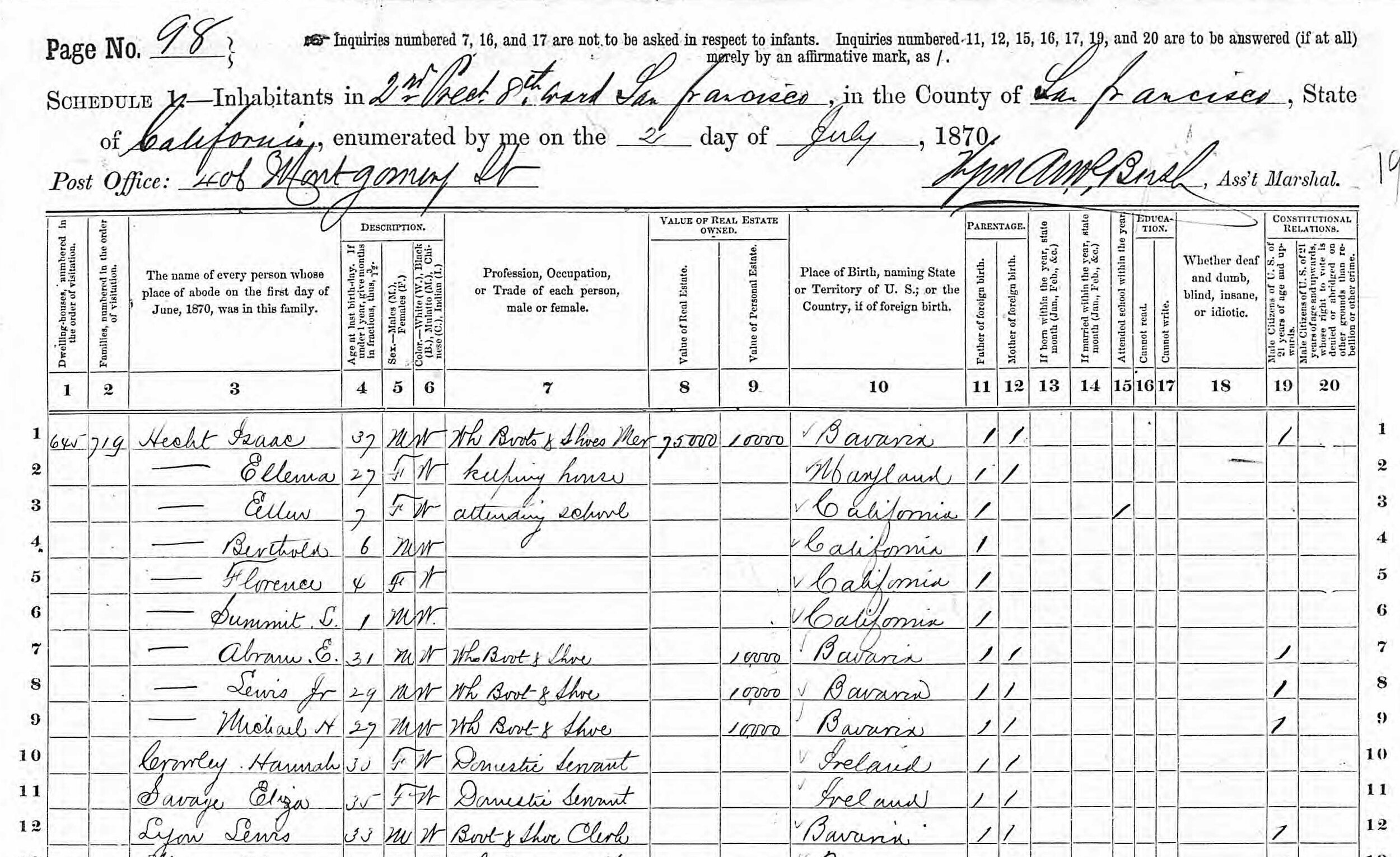
Looking Westward
Sometime around 1856, the Hecht brothers followed the example of other Jewish merchants and headed for San Francisco. The Gold Rush created opportunities for businesses of all kinds, and with their dry goods experience, the Hechts knew they had a chance to make new lives in a new city. They founded their company in 1857 and named it “Hecht Brothers & Co.” choosing to become “jobbers,” or wholesalers, like fellow emigrant Levi Strauss. Their customers were the small general and men’s mercantile stores of the American West. Barrels of shirts, shoes, boots, hats, trousers, and coats arrived in San Francisco with every clipper ship, from east coast manufacturers. The brothers took the goods into their waterfront office and readied them for shipment out to their growing list of retailers.

Early advertisement featuring fellow San Francisco brands Buckingham & Hecht and Levi Strauss
Early advertisement featuring fellow San Francisco brands Buckingham & Hecht and Levi Strauss

The Young Shoemaker
In March of 1840 sixteen-year-old Thomas Buckingham arrived in New York from Liverpool. He’d made his way to that port city from his home in Barnstaple, in the county of Devon in England, and told the man writing up the passenger manifest that he was a shoemaker. How he got his training is unknown, but within two decades his skills would bring him business success beyond the imaginings of a Barnstaple boy. Thomas soon found work as a bookkeeper for a shoe wholesaler named John G. Hein, whose shop was in the heart of San Francisco’s business district and two blocks from Hecht Brothers & Co. As the city and the country began to recover from the shocks of the Civil War, these men would form a new company.

Thomas Buckingham's 1892 passport application
Thomas Buckingham's 1892 passport application


Buckingham & Hecht Opens Its Doors
San Francisco newspapers carried notices of new businesses in their pages, and in the summer of 1866, the Daily Alta California announced the formation of a new Co-partnership: Buckingham & Hecht. The Hecht brothers—Isaac, Jacob, Abraham, and Louis—still managed the company named for them and which imported and sold boots and shoes exclusively. Now, they were also partners with Thomas Buckingham, and their firm set out to manufacture boots and shoes right there in San Francisco. Within two years they had a factory at the corner of Haight and Gough streets, in today’s trendy Hayes Valley. Buckingham & Hecht had taken the first steps to what would become a century-long tradition of fine footwear.

Newspaper advertisement announcing the formation of Buckingham & Hecht. August 28th, 1866
Newspaper advertisement announcing the formation of Buckingham & Hecht. August 28th, 1866

California Manufacture
By the early 1870s the two companies--Buckingham & Hecht and Hecht Bros. & Co.--were taking out joint advertisements in newspapers around the West, and they each had a specialty. Hecht Bros., “Boots, Shoes and Leather,” had an office in Boston too, where brothers Jacob and Louis were now based. The firm was also the exclusive West Coast agent for the famed Hood Rubber Company of Boston, an early pioneer of athletic footwear. Buckingham & Hecht touted their “Extra Quality” boots and shoes, and made sure everyone knew the products were made in California, putting wordy ads in the state’s newspapers touting the quality of California manufacture. Customers liked this idea, and by the end of the decade Buckingham & Hecht boots graced store shelves all over the West: Idaho City and Boise, Seattle, Tucson, and up and down California. The products shared space with another popular item for working men: Levi’s jeans. And the company also got a boost from the U.S. government: a contract to supply boots for U.S. Army troops based on the Pacific coast. The Hechts and Buckingham worked hard to make sure customers knew their boots and shoes were for working men of all stripes.





Dynamite & Boots
Buckingham & Hecht unveiled an innovation and a new trademark as the 1880s got underway. In 1878, the partners patented a “counter and seam protector,” which made their boots even tougher. And they picked an equally tough name for a new boot they introduced in 1880: the Hercules. Associated with strength, this was also the name for a brand of dynamite produced just across San Francisco Bay in the town of Hercules itself. The Hecht brothers and Thomas Buckingham knew they were putting good products on the market, and weren’t shy about letting everyone know. One 1883 advertisement put it this way: “Why pay a large price for a poor boot when you can get the HERCULES.”


Buckingham & Hecht's 1880 trademark application for their famed "Hercules" boot
Buckingham & Hecht's 1880 trademark application for their famed "Hercules" boot

Early ad for the Hercules boot that came with a GUARANTEE for each pair made
Early ad for the Hercules boot that came with a GUARANTEE for each pair made

Daily Lives
The personal lives of the Hecht brothers and their partner Thomas Buckingham were as interesting as their boots. Isaac Hecht was an opera fan, possibly because his wife’s brother was married to a famous opera singer, Julie Rosewald. Isaac also served on a number of committees in San Francisco dedicated to improving the lives of city residents, and sat in many meetings with fellow merchant Levi Strauss. Marcus Hecht was president of the Emporium, a famous San Francisco department store, and was later in life known as “Colonel,” for his service with the California National Guard. Abraham Hecht gave much of his free time to the Eureka Benevolent Society, which helped Jewish families with financial support. Henrietta Hecht married businessman Lewis Wiel, who would later become president of Buckhingham & Hecht. Thomas Buckingham married again and he and his wife bought property in California’s Lake County, about 125 miles north of San Francisco which they named “Buckingham Park.” As the business prospered, Buckingham spent more time at his country place, but he always kept one eye on the firm.

Isaac Hecht pictured in his later years circa 1893
Isaac Hecht pictured in his later years circa 1893

A young "Colonel" Marcus Hecht
A young "Colonel" Marcus Hecht

Colonel Hecht, President of the famed Emporium department store and partner in Buckingham & Hecht was close with President Roosevelt as evidenced in this news blub from 1902
Colonel Hecht, President of the famed Emporium department store and partner in Buckingham & Hecht was close with President Roosevelt as evidenced in this news blub from 1902

Postcard featuring Marcus Hecht's Emporium department store pre 1906
Postcard featuring Marcus Hecht's Emporium department store pre 1906

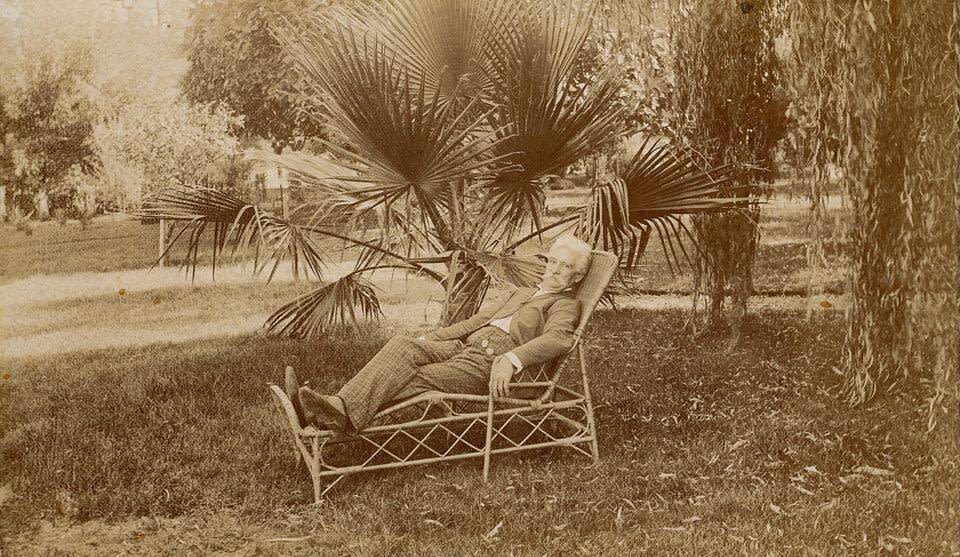
Big Decisions and a Few Goodbyes
In 1887 the partners made two big decisions: they incorporated Buckingham & Hecht, and decided to build a bigger factory. The place in Hayes Valley was now too small to meet the demand for their boots and shoes, so they bought a plot of land at the corner of Valencia and 26th streets, in the Mission district. They constructed a huge manufacturing plant which got up and running by early 1889, and it was so impressive the company put an engraving of the building on their stationery and invoices. But some of Buckingham & Hecht’s officers would only enjoy the benefits of the new factory for about a decade. Isaac Hecht died in 1895, and Abraham Hecht and Thomas Buckingham died in 1898. Bereft of his brothers and their longtime partner, Marcus Hecht carried on.

Tradecard proudly displaying the company's official incorporation date
Tradecard proudly displaying the company's official incorporation date

Thomas Buckingham's obituary from 1898
Thomas Buckingham's obituary from 1898
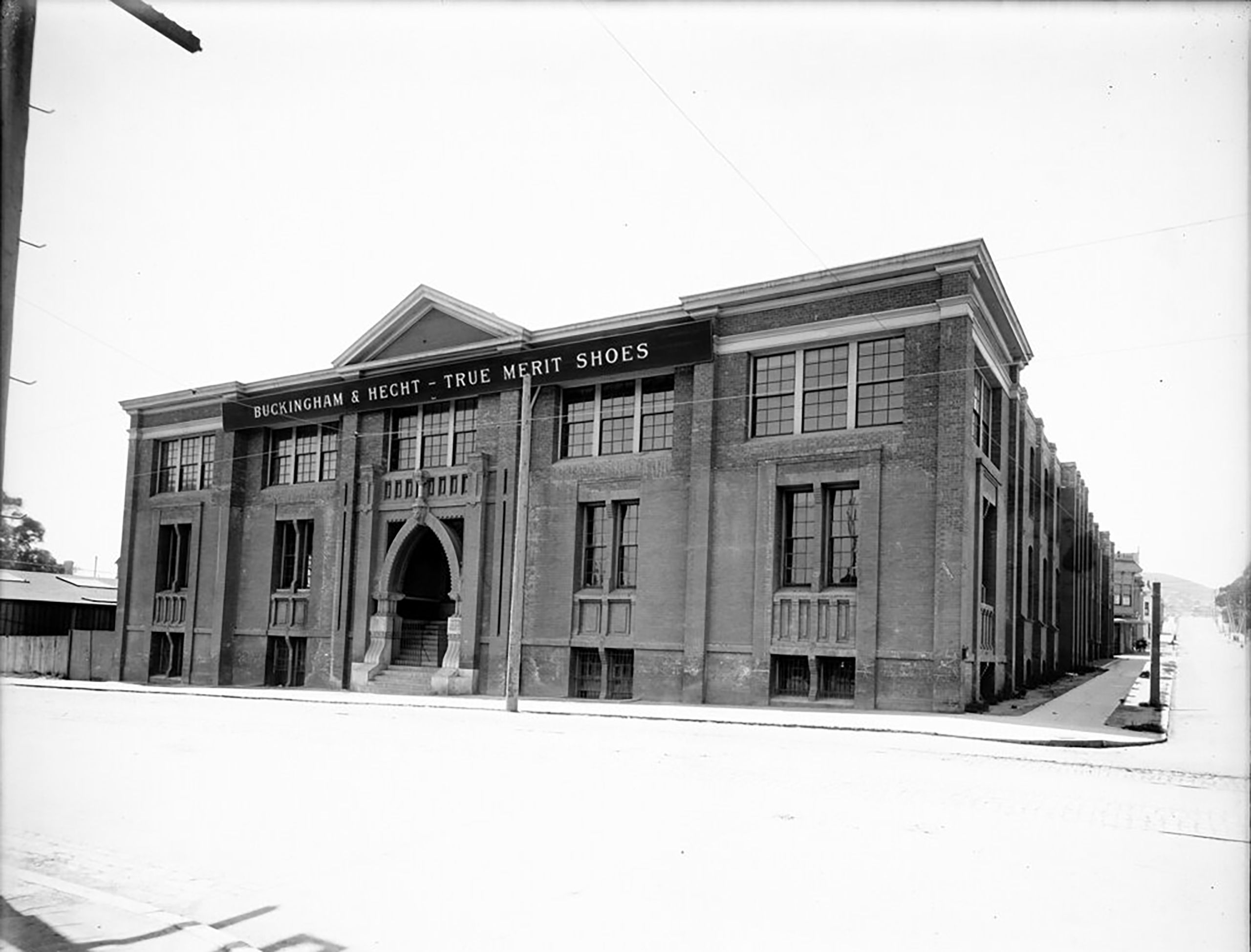
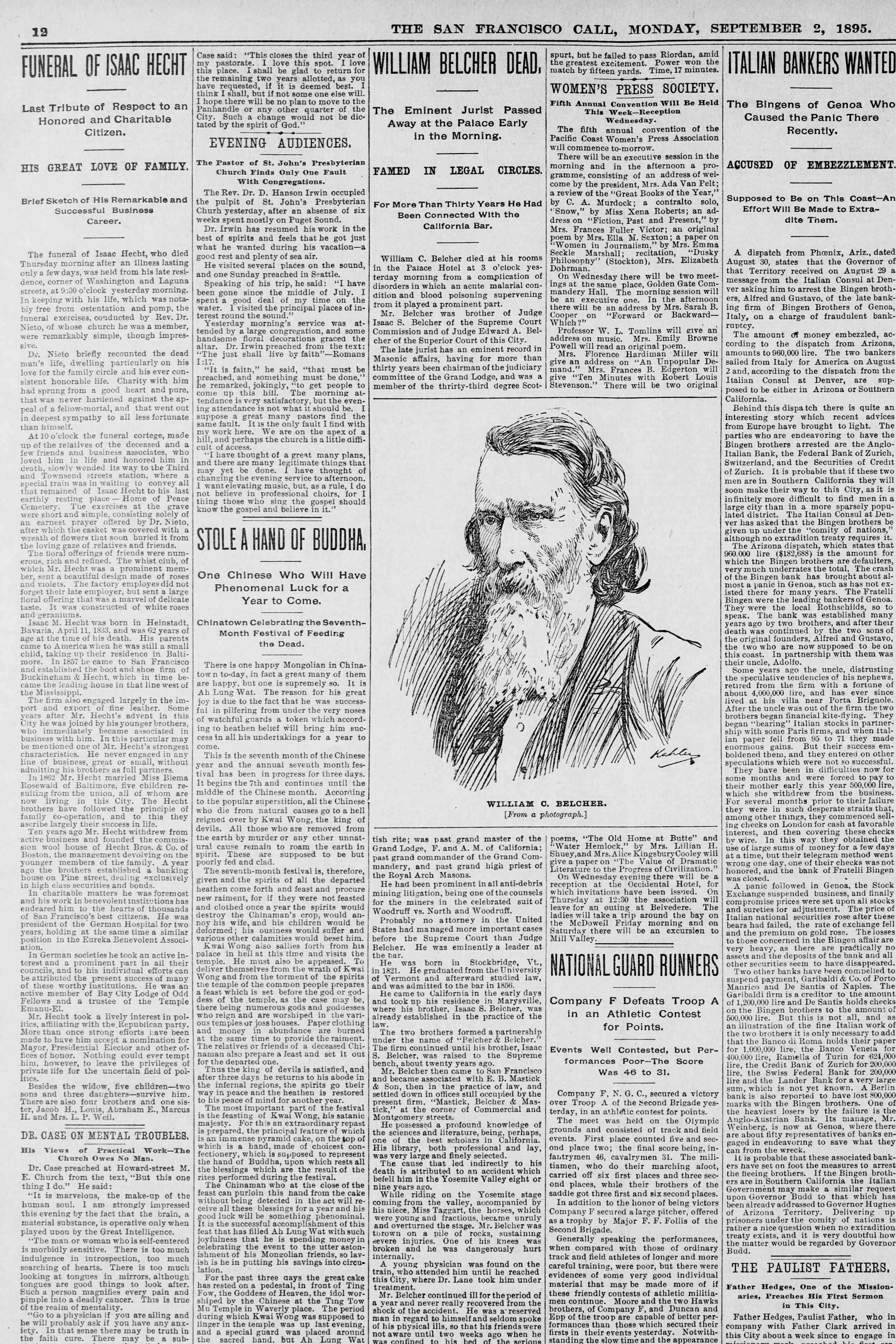
Shaken Up, Bouncing Back
The earthquake of April 18, 1906 and the three-day firestorm which followed destroyed the financial heart of the city, and Buckingham & Hecht’s headquarters on Bush Street was not spared. The factory at Valencia and 26th Streets was well out of range of the fires and it survived, though the building was badly cracked. Marcus Hecht and Lewis Wiel filed insurance claims and then got to work. They transferred all of their office operations to the manufacturing plant, and it reopened for production on May 7, barely three weeks after the disaster. By July, shoes and boots were leaving the loading dock and stores could advertise the famed Hercules boots again, along with its other products. One of these stores was D.S. Rowe in Grass Valley, California, which placed an ad for the Hercules in the Daily Morning Union with the headline “The Old Reliable Boot.” By 1908 the company headquarters was in a new building on Mission Street, in San Francisco’s rebuilt business district.


An excerpt from 1906's The Shoe Worker's Journal documenting that Buckingham & Hecht's factory was one of the fortunate few buildings to survive the big quake
An excerpt from 1906's The Shoe Worker's Journal documenting that Buckingham & Hecht's factory was one of the fortunate few buildings to survive the big quake



The Strongest Leather
In June of 1909 Lewis Wiel had the sad duty of planning the funeral of his partner and brother-in-law, Marcus Hecht. Now the president of Buckingham & Hecht, he carried the company’s traditions forward. He also introduced new ideas and products, with the help of his son, Elias Hecht Wiel, known as Eli, who had joined the family business. Buckingham & Hecht also made a splash in the shoe market in 1909 with the debut of Indian-Tan shoes and boots, “The Strongest Leather on Earth.” Choosing the word Indian for the proprietary name of their leather was a nod to the recent popularity of Native American culture. After Theodore Roosevelt invited a group of Indian headmen to join the parade for his presidential inauguration in 1905, American companies began to use the word Indian and feature indigenous faces on a variety of consumer items. And as they had done for decades, the managers of Buckingham & Hecht touted their California manufacture for the boots and shoes they made for hardworking men. By 1915 the company’s products were being sold as far east as Pennsylvania, and west to Hawaii.

1909 obituary of "Colonel" Marcus Hecht
1909 obituary of "Colonel" Marcus Hecht

Early point of purchase metal sign for the company's many dealers. Circa 1915
Early point of purchase metal sign for the company's many dealers. Circa 1915

1909 advertisement billing Indian-Tan shoes as "Strongest Leather on Earth"
1909 advertisement billing Indian-Tan shoes as "Strongest Leather on Earth"



The Next Generation
Buckingham & Hecht’s president, Lewis P. Wiel, died in November of 1915 and his son Eli, who had been with the company for over a decade, moved into the job. He understood the powerful pull of culture when it came to making boots and shoes, and under his direction, the company expanded its product lines and popularity. Building on the company’s early government contract for military boots, Buckingham & Hecht introduced the Army Shoe in 1916, made with technology created by Dr. Edward Munson, the Army’s chief surgeon. America entered World War I the following year, and the B&H Army Shoe went overseas with the doughboys. Back at home, hikers, sportsmen, mechanics, farmers, and other working men also donned the new shoe, made with the famous Indian Tan leather. With a new product came a new name, and in 1916 Buckingham & Hecht’s shoes and boots now featured the modern moniker Buckhecht.

Dr. Edward Lyman Munson creator of the famed Munson last
Dr. Edward Lyman Munson creator of the famed Munson last


1918 ads touting the Munson last as "the greatest improvement in footwear in a generation"
1918 ads touting the Munson last as "the greatest improvement in footwear in a generation"

1918 "Buckhecht" Army Shoe ad once again side by side with Levi Strauss, who incidentally also had a factory on Valencia Street
1918 "Buckhecht" Army Shoe ad once again side by side with Levi Strauss, who incidentally also had a factory on Valencia Street

Another 1918 Ad for the Army Shoe in black "Gun Metal" or "Indian Tan"
Another 1918 Ad for the Army Shoe in black "Gun Metal" or "Indian Tan"

1918 ad featuring a new logo and the tagline "Established in the early fifties"
1918 ad featuring a new logo and the tagline "Established in the early fifties"


The Jazz Age
The 1920s were all about the end of war and the beginning of Prohibition, which meant going all out to have fun. For many Americans, this meant spending time outdoors, and Buckingham & Hecht’s boots and shoes fit the bill. In 1923 the company introduced Buckstrips, a boot with a tough strip of leather sewed around the vamp for extra strength. Billed as “California’s Favorite Outdoor Shoe,” Buckstrips joined the Army Shoe as one of the company’s most popular products. In that same year, Eli Wiel and his managers released a Style Book of shoes and boots aimed at men and women who were hiking in national parks, riding horses on dude ranches, fishing in pristine streams, and doing heavy work from construction to carpentry. Retailers could order footwear with names that evoked all of this outdoor activity: The Yosemite, The Dakota, The Plainsman, The Sioux, The Trail, The Tourist, and many more.

Nearly 100 year old surviving example of the Buckhect 1924 Ladies boot number 34
Nearly 100 year old surviving example of the Buckhect 1924 Ladies boot number 34

1923 ad with the tagline "Wear California's Favorite Outdoor Shoe"
1923 ad with the tagline "Wear California's Favorite Outdoor Shoe"

1924 Buckhect "Buckmoc" No. 52
1924 Buckhect "Buckmoc" No. 52


Innovation and In Their Own Words
For Buckingham & Hecht, the 1920s were also about innovation. Between 1923 and 1928, Eli Wiel and a number of inventors patented three new processes for improving shoes and boots: the first was for the moccasin-style vamp which created the Buckstrip; the second for an invention to prevent moisture from getting into a shoe; and the third for a method to extend comfort in heavy footwear. Retailers and consumers loved the products, and sent testimonials to Buckingham & Hecht headquarters. Some of these were included in the 1923 Style Book. For example, the owner of the Elko Shoe Shop in Nevada wrote: “Practically every person in Elko who has purchased a Buckhecht shoe is still buying them from us. No other shoe will do.” And the Bingham Merc. Co. in Bingham Utah sent in this praise: “We are located in a mining town, where it requires shoes of quality to stand the hard knocks, but we have very seldom had any complaint on Buckhechts.”

Woven label circa 1923
Woven label circa 1923

Excerpt from 1924 wholesale catalog
Excerpt from 1924 wholesale catalog


The Cowboy Way
The Buckingham & Hecht 1924 catalog included something new: cowboy boots. With names like Bronco and Royal Cowboy, the products were a departure from the outdoor themed footwear the company was already famous for. Eli Wiel and his managers saw how the cowboy and the story of the West had become more popular in films, books, and clothing design. It made sense to lasso this cultural icon, and to do so they needed some help. In 1926 Buckingham & Hecht bought the Starnes Shoe Co. of Colton, California, known for making fine cowboy boots. Colton, by the way, is also famous for being the home of Virgil Earp after he participated in the gunfight at the O.K. Corral in Tombstone, Arizona. His brother Morgan, assassinated in Tombstone in 1882, is buried in Colton. With this cowboy street cred behind it, Starnes Shoe was the perfect company to bring western flair to Buckingham & Hecht’s product lines. As the 1920s progressed and welcomed a new decade, retailers could advertise Buckhechts as the perfect product for work, leisure, or the great outdoors.







Early 1930s Ads featuring both the Buck-Hect brand and newly acquired Starnes brand boots with the tag line "Made in the West for Westerners"
Early 1930s Ads featuring both the Buck-Hect brand and newly acquired Starnes brand boots with the tag line "Made in the West for Westerners"



Tough Times
The Depression of the 1930s was hard on all American companies, including Buckingham & Hecht. But president Eli Wiel knew he still needed to be creative and innovative to say in the market. New and interesting products made their debut in this decade: Oro-Peds, known as Health Work Shoes, made for people with narrow feet and weak arches; Loggers, a “low boot for every outdoor man;” the Marching Shoe, which took over after the company discontinued the Army Shoe in the mid-1920s; and the Riding Shoe, a fancy trim low shoe with a cowboy heel called “The Dress Shoe for the Buckaroo.” These products sustained the company through the 1930s, but many would disappear as World War II approached. All except one: the Buckbot, a sporty and form fitting boot introduced around 1935 and destined to become one of most iconic pieces of men’s footwear.







1939 ad for Buckhect's "Buckbot", an earlier iteration of the now iconic engineer boot
1939 ad for Buckhect's "Buckbot", an earlier iteration of the now iconic engineer boot



The Man on the Job
When World War II began in the United States, Buckingham & Hecht knew its boots were perfect for the men working in defense industries. They put this into the language of their advertising, as in this example from the San Francisco Examiner in March of 1942: “Welders, Ship Fitters and workers, requiring sturdy footwear, are properly taken care of when wearing BUCKHECHT shoes. Bucking & Hecht consider it their duty to offer to defense workers a shoe made for defense work service at reasonable cost to the man on the job.”


February 1942 Honolulu newspaper ad with the slogan: for the man behind the man behind the gun
February 1942 Honolulu newspaper ad with the slogan: for the man behind the man behind the gun




From Function to Fashion
After the war was over, Americans moved into the suburbs and men got back to work. Buckingham & Hecht boots were still the go-to footwear for shipbuilders, welders, mechanics, and cowboys. And one popular item, the Buckbot, got a new name. This tough leather boot had been in the line since about 1935, and was called a Strap Boot. It was a mashup of a Logger with the style of an English riding boot, and in 1950 it got a new name: Engineer Boot. Three years later, Marlon Brando put this product on the path to stardom when he wore engineer boots in the classic motorcycle rebel film, The Wild One. The movie inspired generations of equally rebellious men and women to don jeans, a leather jacket, and a pair of engineer boots, made mostly notably by Buckingham & Hecht. These boots are among the most iconic and collectible vintage footwear today.

Rare surviving example of Buckhect's iconic Indian-Tan engineer in black. Date unknown
Rare surviving example of Buckhect's iconic Indian-Tan engineer in black. Date unknown

1950 Ad for Buck-Hect's iconic double leather sole engineer
1950 Ad for Buck-Hect's iconic double leather sole engineer

1950 Ad for Buck-Hect's newest lug sole Engineer boot model no.128
1950 Ad for Buck-Hect's newest lug sole Engineer boot model no.128

1942 ad featuring Buck-Hect's "Buckbot" engineer in either leather or cord (rubber) soles
1942 ad featuring Buck-Hect's "Buckbot" engineer in either leather or cord (rubber) soles


The Solnit Years
In 1950, the same year the company unveiled the Engineer Boot, Eli H. Wiel, president of Buckingham & Hecht, sold the firm to the Solnit Shoe Company of Los Angeles and San Francisco. Now 77 years old, the last member of the Hecht family decided it was time to pass the business into other hands. Ben Solnit had founded his firm in Los Angeles in the mid-1930s and later expanded to San Francisco. He knew the Buckingham & Hecht name was a powerful force in the shoe industry, and Solnit’s catalogs and advertising always called out the B&H name. Ben Solnit himself died suddenly in 1955, but the company managers kept up the tradition, and Buckingham & Hecht shoes and boots for men and boys continued to be front and center in marketing.Company catalogs in the early 1960s carried traditional and new Buckingham & Hecht products. The Engineer Boot, available in the still-famous Indian Tan, was the star of the collection called “Buckhecht Job-Rated Work Shoes.” New on the scene for boys was the wildly popular brown Desert Boot, worn by the Beats of San Francisco and the rockers of swinging 1960s London. But by 1967 the Buckingham & Hecht name, as well as its products, had faded from the Solnit line, and from memory. Then, in 1969, Solnit itself was sold to Volume Shoe Corporation, which became Payless Shoe Source in 1991.

October 17th, 1950 San Francisco Examiner announcement of brand's sale to the Solnit Shoe Company.
October 17th, 1950 San Francisco Examiner announcement of brand's sale to the Solnit Shoe Company.

The Solnit Shoe Company's main office and retail store at 817 South Los Angeles Street circa 1961
The Solnit Shoe Company's main office and retail store at 817 South Los Angeles Street circa 1961

Ad for Buckingham & Hecht's 1960 desert boot
Ad for Buckingham & Hecht's 1960 desert boot

Solnit/Buckhecht's expansive sales team pictured in 1961
Solnit/Buckhecht's expansive sales team pictured in 1961




Excerpts from the 1961-1962 catalog.
Excerpts from the 1961-1962 catalog.

The 1951 obituary of Eli Wiel, who served as President of Buckingham & Hecht for 35 years
The 1951 obituary of Eli Wiel, who served as President of Buckingham & Hecht for 35 years

Announcement of sale to Volume Shoe Corporation in 1969
Announcement of sale to Volume Shoe Corporation in 1969
